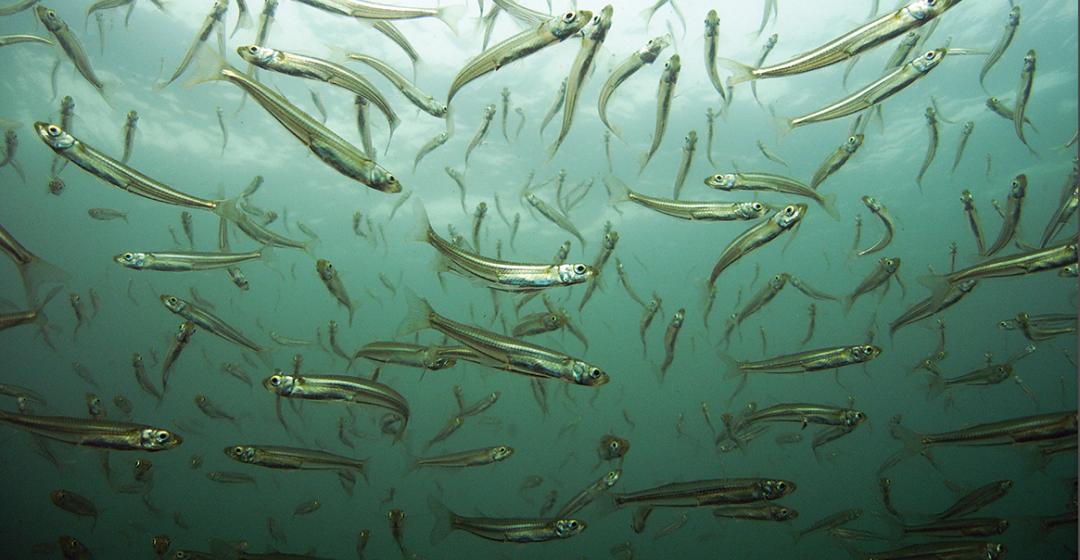One summer’s day, the sun a diamond in the sky, I rowed the length of Menemsha Pond. The journey began in the boat basin on the Lobsterville side, where I entered the creek’s incoming currents, pointing my dory southward. Stroking eighteen-foot oars, I slid past the remains of Orca-2, onward to Picnic Point, all the while Nashaquitsa in my sights.
My self-imposed mission was to enjoy the day, do a little fishing, and watch for wildlife. As the current eased, I stood, drifting silently, drinking in the pond’s beauty with an eye out for fish. Soon enough some appeared. Like ghosts, fleeting shadows and flashes of silver traveled the shallows of Long Bar, silently announcing the presence of one of the most common residents of our nearshore waters – Menidia menidia, the Atlantic silverside.
Silversides are small, slender forage fish – which is to say prey for larger fish – that grow to upwards of five inches. If you held one in your hand, you would find their coloration a translucent olive-green, their top side bearing faint hatch marks, their midline home to their namesake – a distinctive silver stripe. They spawn in estuaries and salt ponds on daytime high tides, after the water temperature warms in the spring. On the Vineyard, May and June are prime months, though silversides can spawn several more times during the summer. They gather a short distance off the beach, especially in the days surrounding the new and full moons, and then move into the intertidal zone to deposit eggs where marine grasses grow. The presence of terns, gulls, and cormorants typically heralds the event.
Sometimes called sperling, spearing, or white-bait, silversides are found from the chilly northern waters off Prince Edward Island in Canada southward to the warm Florida shores. Throughout this range, they typically live but a year. Yet in that time, they are a forage base for shorebirds and fish – including striped bass, bluefish, fluke, weakfish, and Atlantic bonito.
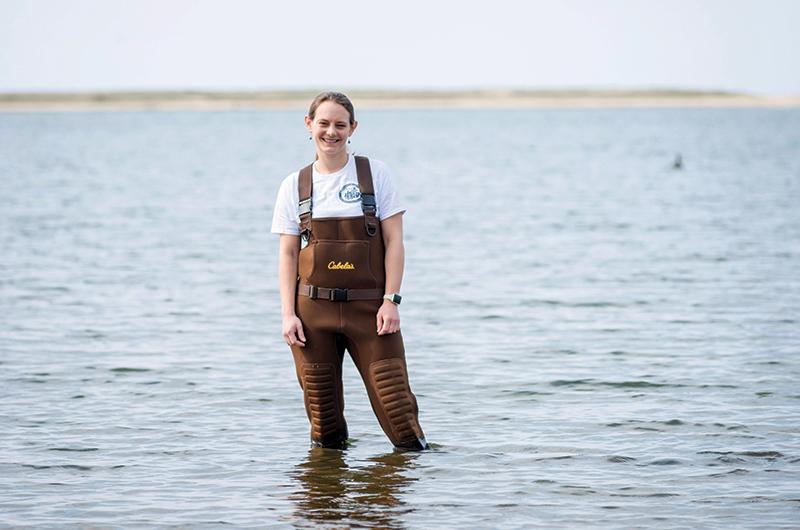
Despite being at the foundation of the marine ecosystem, silversides have never received much public attention. You won’t find their image gracing T-shirts, bumper stickers, or hats. Nor should you expect wood carvings or watercolors of them in gift shops. Lacking either recreational or commercial popularity, silversides are the Rodney Dangerfield of our protected waters – easily overlooked, easily taken for granted. Even people with a working knowledge of our Island’s salt ponds may not be able to tell you much about silversides.
There are people who have devoted their life to understanding them, however. One of them is Julie Pringle, formerly the scientific program director for the Edgartown-based Great Pond Foundation, now deputy shellfish warden at the Edgartown Shellfish Department. Born and raised on the Vineyard, Pringle wrote her master’s thesis on the Atlantic silverside while attending the University of Connecticut. She sees them through educated eyes and speaks about them in full paragraphs.
“The Atlantic silverside is found in all of the Island’s salt ponds and are likely the most abundant forage fish in our shallow waters, serving as prey for a great many commercially and recreationally important species,” said Pringle.
“That alone makes silversides a critical part of the Island’s ecosystem. But the story doesn’t end there. It would be wrong to assume that their impact is felt only in nearshore waters. Each winter, silversides move offshore to avoid the winter cold. While there, [an estimated 90] percent of them are consumed by other fish, leaving [about 10] percent of the silverside population to return and spawn in the spring. In this way, silversides do an important service to the surrounding ocean, sharing the rich nutrients of the estuaries with the more sterile blue waters.”
One of those nutrients that silversides take offshore is nitrogen. Among the ever-growing community of people concerned about the health of our protected waters, it’s a hot-button word. Excessive nitrogen in salt ponds and brackish water is doing a great deal of harm and threatens, if not better controlled, to do more. In particular, nitrogen is harming the Island’s eelgrass, especially the deeper beds, by accelerating phytoplankton blooms, which reduce the amount of sunlight eelgrass receives for photosynthesis.

This is a very real concern. Eelgrass beds provide indispensable habitat for numerous marine species, including shellfish. And eelgrass beds are difficult to restore. Nitrogen is also implicated in the rise in blue-green algae blooms during July and August on the Island in recent years, some of which can be toxic to pets and humans.
Roughly half of the excess nitrogen in our ponds comes from septic systems. Another 30 percent comes from lawn and agricultural fertilizer runoff, and 20 percent comes from rain. Silversides can’t save us from making the seemingly simple choices ahead, such as forgoing that bright green lawn to prevent a blue-green pond. Nor can the tiny fish head off the expensive choices, such as replacing septic systems with modern water treatment. But, Pringle said, “while the amount of nitrogen silversides transport offshore may not be enormous, it is still significant given the daunting and dangerous problem nitrogen loading is causing.”
That the world is interconnected is hardly news. Still, it may be surprising to realize that the clouds of silversides often seen shimmering the surface just off the shoreline, or the ones I encountered on a summer morning along the bar in Menemsha Pond, are helping to correct our impact on the marine environment. It is a reminder of the intricacy of our planet, how even a small fish can play a significant role.
And it’s not silversides’ only major contribution. Because the species can be grown in a laboratory, marine biologists often rely on silversides to research a number of issues, including how fish might react to climate change and an altered marine ecosystem.
Christopher Murray, a postdoctoral investigator at Woods Hole Oceanographic Institution, is deeply involved in understanding how climate change is altering the ocean, including the effects of rising water temperatures, decreasing oxygen levels, and the increasing acidification of ocean waters due to CO2 absorption. One of his areas of research is ecophysiology, the study of how living organisms react to varying stresses in their environment.
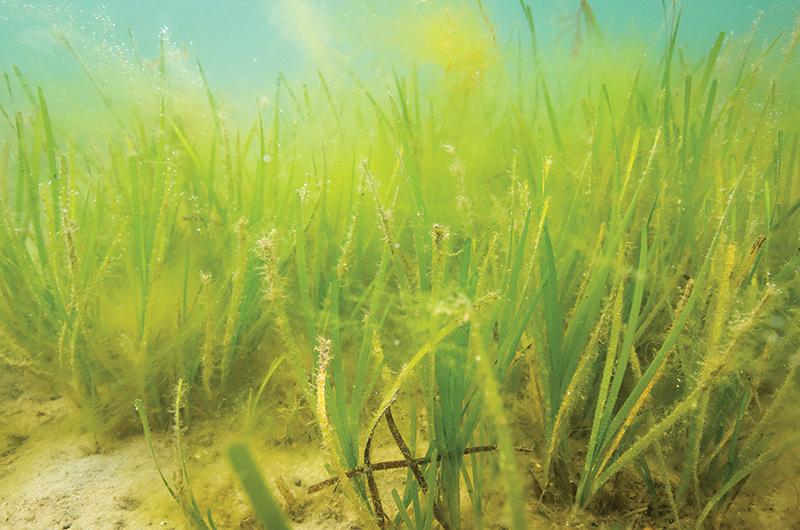
Silversides provide a near ideal species for this type of research, he said, because biologists can easily observe them first-hand over several generations in the lab. This research has been going on for decades, producing valuable insights into how fish handle a diverse and shifting world.
One such crucial finding has to do with genetic adaptation in fish, Murray explained over the phone from his lab in Woods Hole. While it was once believed that genetic adaptation for highly complex animals, such as fish, was an extremely slow process necessitating enormous amounts of time, silverside research has shaken up that theory.
“We have learned...that silversides can, inside a few generations, evolve to take on stressors in the ecosystem both physiologically and genetically and thereby enhance their survival,” he said. “This is a good sign, showing that nature has provided a pathway for wildlife to alter themselves when survival demands it. And it provides hope that fish can successfully face challenges brought on by climate change.”
Murray, who, like Pringle, studied at the University of Connecticut, where he earned his PhD, said the single biggest challenge fish likely face today is responding to rising water temperatures. Right now, the distribution of fish along the Atlantic seaboard is largely limited by a given species’ water temperature tolerance. After all, the vast majority of fish are cold-blooded and have evolved over time to exist inside a specific temperature envelope. Consequently, warming water could easily threaten many species’ survival, especially if they can’t readily adapt or migrate.
On the other hand, Murray points out that some species may be far more able to deal with rising water temperatures than others. Once again, silversides provide some answers.
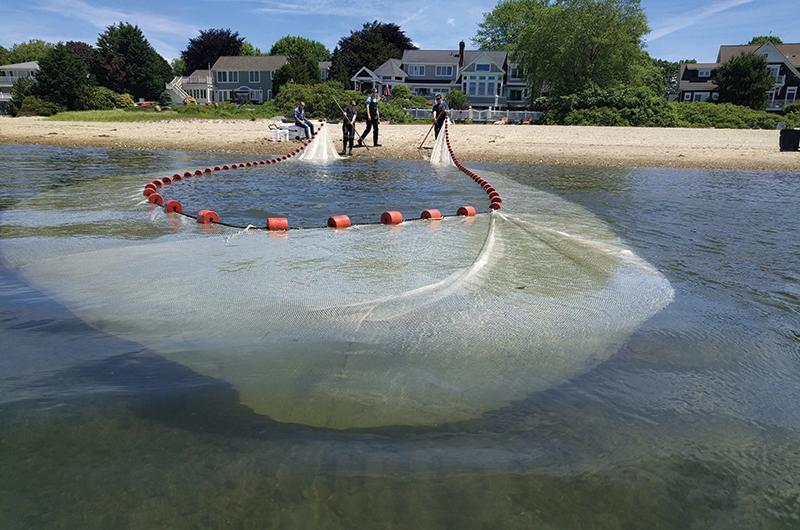
Because they thrive over an enormous latitudinal range, from northern Florida to Canada, silversides permit biologists to examine how a species can modify itself to accommodate diversities in water temperatures and different growing and breeding seasons. For instance, even though the water is much colder and the growing season far shorter in northern latitudes, northern silversides have learned to grow faster to make up for it.
Scientists call this a “counter-gradient” response, as a higher capacity for growth counters cold temperatures. Other species along the Atlantic seaboard with a broad latitudinal range, such as striped bass, have similar counter-gradient capabilities. These species are better equipped to handle temperature change in their environment.
Mixed in with the issue of climbing water temperatures are other major questions. Will species unable to migrate also be unable to reproduce, causing their population to plummet? Can the fish that do migrate in search of better conditions find new spawning grounds? And will they be able to successfully reproduce in these locations? Along with these questions, there are additional complexities.
“I contributed to several studies showing that ocean acidification and hypoxia can reduce embryo survival in silversides,” Murray explained. “The conditions we tested regularly occur in silverside nursery habitat. Clearly, if high CO2 and low oxygen can damage embryos, then it will reduce spawning success.”
Research of silversides was also responsible for the discovery that water temperature during the breeding season can have a large impact on the sex of the offspring. Scientists call this effect temperature-dependent sex determination, or TSD. “Silversides born during the coolest part of the season are predominately female, while silversides born in the warmest part are largely male,” said Murray.
“While TSD was first discovered in silversides, we have since learned it is a widespread phenomenon in many other fish species. We are learning as well that it is more common in the wildlife community than we previously thought. For instance, TSD is found in turtles and many other reptiles.”
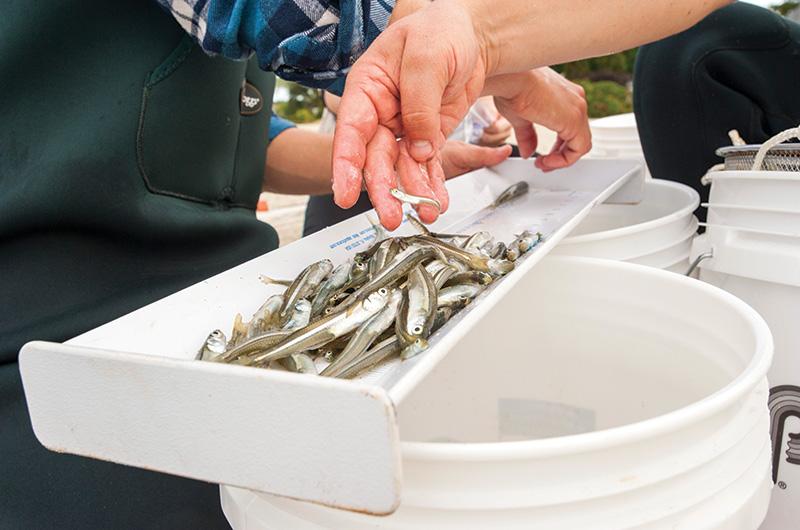
When it comes to how rising temperatures will affect the sea life of New England, Murray said there could be changes in gender balance, reproductive success, and growth rates of silversides and other resident species. Some species we consider native may migrate north, while others from warmer southern waters, such as black sea bass, are already moving in.
There are more questions than answers. “We do know,” he said, “that the current rate of warming is faster than what animals have encountered in their evolutionary history.”
Murray’s investigations into both oceans and ecophysiology place him in a unique position to speak not only to issues facing us in the Northeast, but also offer a wider view of things forthcoming.
“Overall, I have mixed feelings about the future,” Murray said, when pressed to describe the road ahead. “On the one hand, we don’t have a crystal ball. So, we don’t exactly know what climate change has in store for us. Regardless, I think the future largely depends on us.
“Will we develop the necessary public policies to reduce CO2 emissions? Will we step up to conserve and preserve critical habitat, especially in our estuaries? After all, these are the principal spawning and nursery ground for the vast majority of coastal fish, species we rely on. And can we develop better fisheries management to protect the fish we have – fisheries management that can respond to a changing environment? Ultimately, we hold the key.”
While they dodge hungry bass and bluefish from below and diving terns from above, and carry some of our excess nitrogen from the blue-green ponds to the deep blue sea, silversides are evolving as fast as they can. The question is: will we?

